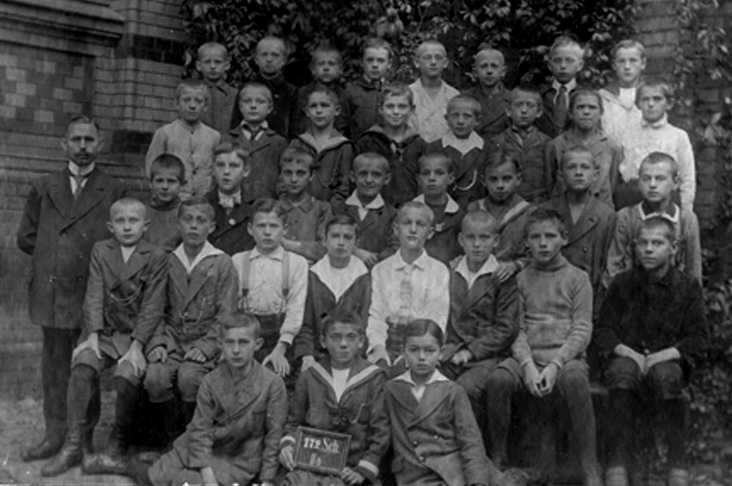
Schoolwear Hosiery: Long Stockings--Country Trends

Figure 1.--This German school portrait is unidentified. We do not know where it was taken, but I think it says "172 Sch" on the little placard, which may means School No. 172". The "IIIa" means that they were in the third year of Grundschule/Volkschule. There is a 1912 notation on the back,
but I think this is just a guess. From the style of the teacher's dress and other factors I think the picture dates from about 1912-20. Note the variety of the boys' school clothes. All of them wear knee pants with black long stockings (typical of the 1910s), but the relative informality (Schiller collars, suspenders without jackets,
sailor suits, a few neckties here and there) makes us think that maybe I should move the date forward to the latter-1910s. The boys seem to me about 8-9 years old.
|
|
Many boys in the late 19th century wearing kneepants wore long stockings held up with stocking supporters. This was very common in both Europe and America for both boys and girls. There was some differences from country to country. Here climate was a factor. American boys, although they did not commonly wear school uniforms, by the 1870s were commonly wearing kneepants and long stockings to school. British schools varied greatly in school uniform requirements. Many schools did not rigidly enforce uniforms. Many school boys wore long pants and thus long stockings do not appear to have been as common as in the United States. Long stockings began to disappear in the early 20th century as knickers and short pants began to replace kneepants. Long stockings continued to be worn to school in several countries with severe winters, the Scandanavian countries, Poland, Germany, Russia, and a few other countries. We also notice long stockings in Japan. They were worn to school, but usually not as part of a school uniform. We note them declining in popularity in America during the 1930s. We continue to see them in Germanu into the 1950s and in the Soviet Union even in the 60s.
America
American boys, although they did not commonly wear school uniforms, by the 1870s were commonly wearing kneepants and long stockings to school. Most American boys wore long stockings with knee pants and knickers in the early-20th century. Knee socks appeared in the 1920s and by the early-1930s were quite common with knickers. We note them long stockings declining in popularity in America during the 1930s. After World War II (1939-45) most boys wore ankle socks.
Canada
England
British schools varied greatly in school uniform requirements. Many schools did not rigidly enforce uniforms. Many school boys wore long pants and thus long stockings do not appear to have been as common as in the United States. Long stockings began to disappear in the early 20th century as knickers and short pants began to replace kneepants.
Germany
German boys wore a range of hosiery to school and this changed over time. Seasonality was another factor. We notice three-quarter socks and long stockings in the early 20th century. Kneesocks gradually became very common. Long stockings went out of style in the 1950s, but continued to worn in East Germany a little longer than in West Germany.
Japanese elementary children through World War II (1941-45) often wore long stockings with the generally long knee-length short pants, especially during the winter. We still see long stockings after the War in the 1940s and 50s. They seems to have disappeared as shorter cut short pants began to become in the late 50s. Also tights appeared about the same time. We are not entirely sure about the age comventions, but they were mostly worn by younger children. Younger children began wearing tights during the winter. The stockings were apparently not very popular with the children, they were worn by both boys and girls. Yukio Mishima wrote in his autobiographical novel, Confessions of a Mask. The time would have been the late-1930s. "It was well into the winter of my second year in middle school. By then we had become accustomed to long trousers and to calling each other by unadorned surnames. (In lower school we had never been permitted to leave our knees bare below our short pants, not even in the height of summer, and thus our joy at first putting on long trousers had been doubled by the knowledge that never again wold we have to garter our thighs painfully. In lower school we had also had to use the formal form of address when calling each other by name.)"
Poland
Russia
We continue to see them in Germanu into the 1950s and in the Soviet Union even in the 60s.
Sweden
Long stockings continued to be worn to school in several countries with severe winters, the Scandanavian countries, Poland, Germany, Russia, and a few other countries.
HBC-SU

Related Chronolgy Pages in the Boys' Historical Web Site
[Main Chronology Page]
[The 1900s]
[The 1910s]
[The 1920s]
[The 1930s]
[The 1940s]
[The 1950s]
[The 1960s]
[The 1970s]
[The 1980s]
[The 1990s]
[The 2000s]
Navigate the Relate Boys Historical Clothing School Uniform Garment Pages
[Return to the Main school long stockings page]
[Return to the Main school hosiery type page]
[Main garment page]
[Blazers]
[Bookbag]
[Caps]
[Coats]
[Kilts]
[Pants]
[Shirts]
[Shoes]
[Smocks
[Suits]
[Seaters]
[Ties]
Navigate the Boys' Historical Clothing School Uniform Country Pages
[Main School Uniform Page]
[Main National School Uniform Page]
[Australia]
[England]
[France]
[Germany]
[Ireland]
[Italy]
[Japan]
[New Zealand]
[Poland]
[Singapore]
[Scotland]
[Singapore]
[United States]
Navigate the Boys' Historical Clothing Web Page
[Introduction]
[Activities]
[Biographies]
[Chronology]
[Clothing styles]
[Countries]
[Bibliographies]
[Contributions]
[FAQs]
[Glossary]
[Images]
[Links]
[Registration]
[Tools]
[Boys' Clothing Home]
Created: 2:23 AM 6/21/2008
Last updated: 8:56 PM 8/8/2009




